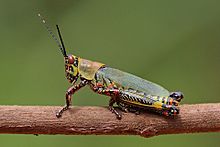Zonocerus
Due to formal or content deficiencies in the quality assurance biology in the section "Insects" for improvement, this article has been entered. This is done in order to bring the quality of the biology articles to an acceptable level. Please help improve this article! Articles that are not significantly improved can be deleted if necessary.
Read the more detailed information in the minimum requirements for biology articles .
Reason: Description is missing - what distinguishes the genus from other cone-head horrors? Why are the two species united in a common genus?
| Zonocerus | ||||||||||
|---|---|---|---|---|---|---|---|---|---|---|

Zonocerus elegans , recorded in Zambia |
||||||||||
| Systematics | ||||||||||
|
||||||||||
| Scientific name | ||||||||||
| Zonocerus | ||||||||||
| Stål , 1873 |
Zonocerus , also called harlequin terrors , is a genus of short- antennae terrors (Caelifera) of the cone-headed terrors family (Pyrgomorphidae) and the Phymateini tribe. The only two species arewidespreadin the tropical rainforest and near-forest savannahs of Africa, Zonocerus elegans mainly in central and southern regions, including Madagascar, and the harlequin shrimp ( Zonocerus variegatus ) in West and East Africa. Both species are important agricultural pests , especially in banana plantations, and are able to store pyrrolizidine alkaloids from food plants such as the widely cultivated milkweed manioc ( Manihot esculenta ) in their cuticula .

species
- Zonocerus elegans ( Thunberg , 1815): type species ; the form originally described by Thunberg as Gryllus elegans is now considered a subspecies Zonocerus elegans elegans .
- Harlequin Terrier : Zonocerus variegatus ( Linnaeus , 1758)
Combat
Conventional insecticides are largely ineffective against Zonocerus . A mixture of peanut oil and the conidia of the fungus Metarhizium flavoviride , which attacks Schnabelkerfe , proved to be effective . Spraying the oily mixture resulted in high mortality in the harlequin insect, with 70 to 95% of the insects dying.
Individual evidence
- ↑ a b M. Boppré, OW Fischer: Harlequin terrors (Orthoptera: Zonocerus) - harmful insects of a special kind. In: Healthy plants. 51, 1999, pp. 141-149.
- ↑ a b Roskov Y., Kunze T., Orrell T., Abucay L., Paglinawan L., Culham A., Bailly N., Kirk P., Bourgoin T., Baillargeon G., Decock W., De Wever A. ., Didžiulis V. (ed): Species 2000 & ITIS Catalog of Life: 2011 Annual Checklist. . Species 2000: Reading, UK .. Retrieved September 24, 2012.
- ^ RF Chapman, WW Page, AR McCaffery: Bionomics of the Variegated Grasshopper (Zonocerus Variegatus) in West and Central Africa . In: Annual Review of Entomology , Volume 31, January 1986, pp. 479-505, doi : 10.1146 / annurev.en.31.010186.002403 .
- ↑ EA Bernays, RF Chapman, EM Leather, AR McCaffery, WWD Modder: The relationship of Zonocerus variegatus (L.) (Acridoidea: Pyrgomorphidae) with cassava (Manihot esculenta) . In: Bulletin of Entomological Research , Volume 67, No. 3, September 1977, pp. 391-404, doi : 10.1017 / S0007485300011202 .
- ↑ CJ Lomer, RP Bateman, I. Godonou, D. Kpindou, PA Shah, A. Paraiso, C. Prior: Field Infection of Zonocerus variegatus following application of an oil-based formulation of Metarhizium flavoviride conidia . In: Biocontrol Science and Technology , Volume 3, 1993, pp. 337-340, doi : 10.1080 / 09583159309355288 .